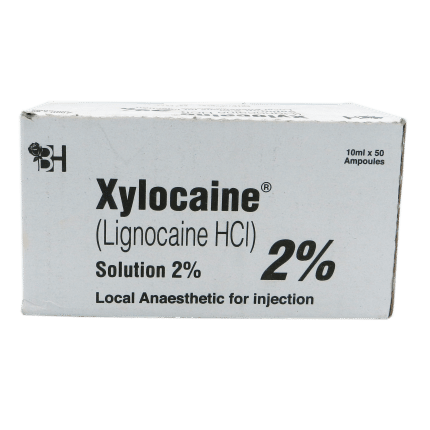Xylocaine 2% Injection contains the active ingredient Lidocaine, also known as Lignocaine, and is a local anesthetic medication used for numbing or blocking pain sensations in a specific area of the body.
Key Ingredient and Its Benefits:
- Lidocaine (Lignocaine): It works by inhibiting the transmission of nerve signals in the area where it is applied, thereby temporarily numbing the area and reducing pain sensations.
Uses:
Xylocaine 2% Injection is indicated for various medical purposes, including:
- Local anesthesia for minor surgical procedures such as dental procedures, skin biopsies, and suturing of wounds.
- Numbing of mucous membranes during certain medical procedures such as endoscopy, cystoscopy, and bronchoscopy.
- Pain relief during medical interventions such as catheter insertion, injections, or minor dermatological procedures.
Dosage and Administration:
The dosage and administration of Xylocaine 2% Injection depend on the specific procedure being performed, the patient’s age and weight, and the area to be anesthetized. It is usually administered topically, by infiltration (injection) into the tissues surrounding the area to be anesthetized, or by nerve block under medical supervision. The dosage should be determined by a healthcare professional based on individual patient factors.
Precautions:
- Xylocaine 2% Injection should be used with caution in patients with a history of hypersensitivity reactions to local anesthetics or any other ingredients in the solution.
- Care should be taken to avoid accidental intravascular injection, as systemic absorption of lidocaine may lead to adverse effects such as central nervous system depression, cardiovascular collapse, or seizures.
- Inform your healthcare provider about any pre-existing medical conditions, allergies, or medications you are currently taking before undergoing any procedure involving Xylocaine 2% Injection.
Side Effects:
Common side effects of Xylocaine 2% Injection may include temporary numbness or tingling at the site of administration, redness or swelling, and mild discomfort or irritation. Serious side effects such as allergic reactions, difficulty breathing, or irregular heartbeat are rare but may occur. Contact your healthcare provider if you experience any persistent or severe side effects.
FAQs:
- How long does the numbing effect of Xylocaine 2% Injection last? The duration of numbness or anesthesia provided by Xylocaine 2% Injection may vary depending on the dose administered, the site of application, and individual patient factors. Typically, the effects last for about 1 to 2 hours.
- Is Xylocaine safe for use in children and elderly patients? Xylocaine may be used in children and elderly patients under medical supervision. The dosage and administration should be adjusted based on age, weight, and individual patient factors. Consult a healthcare professional for appropriate dosing recommendations in these populations.
- Can Xylocaine be used during pregnancy or breastfeeding? Xylocaine should be used during pregnancy or breastfeeding only if clearly needed and under the supervision of a healthcare provider. The potential benefits and risks should be carefully evaluated before use in pregnant or breastfeeding women.
- What should I do if I accidentally receive an overdose of Xylocaine? If an overdose of Xylocaine occurs, seek immediate medical attention or contact a poison control center. Symptoms of overdose may include drowsiness, confusion, seizures, or cardiac arrhythmias.
- Can Xylocaine be used for pain relief in conditions other than minor surgery or medical procedures? Xylocaine may be used off-label for certain conditions requiring local anesthesia or pain relief, as determined by a healthcare professional. However, the use of Xylocaine for any condition should be based on clinical judgment and individual patient factors.






Reviews
There are no reviews yet.